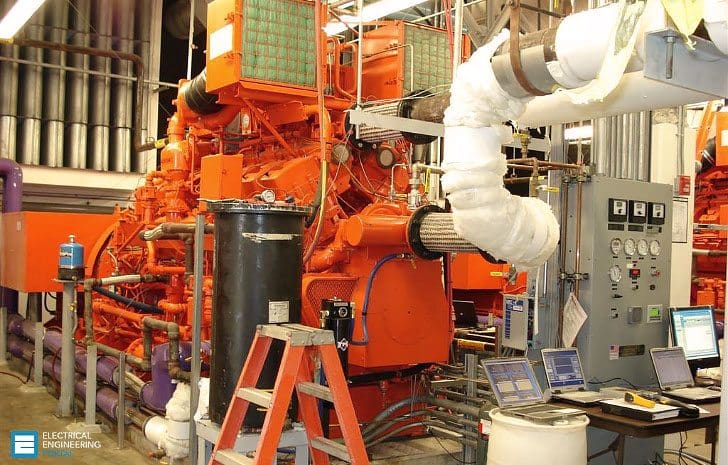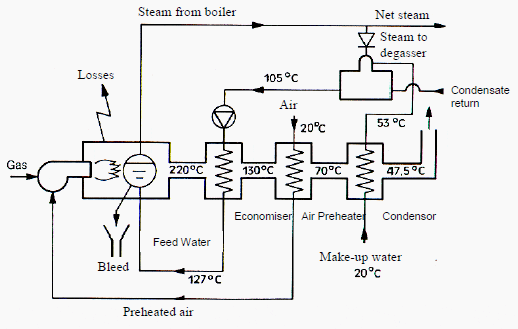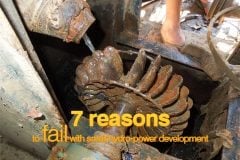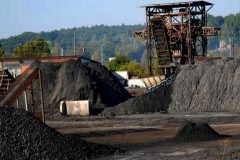The Steam
Steam is used a great deal in hospitals: it permits high energy densities and enables large amounts of energy to be moved around easily. Steam can easily be generated from water, which is present everywhere in large quantities.

Furthermore, steam installations are relatively easy to regulate. Steam is used for many applications in hospitals, including sterilisation, humidification, heating and providing hot tap water.
However, that heating with steam is not always the best solution, as a heating system that operates at lower temperature is more suitable for space heating.
For generating and distributing steam it is important to observe the following rules of thumb:
Ensure Good Pipe Insulation
The losses from an uninsulated pipe are huge. Fittings such as valves and flanges must also be well insulated. By way of illustration, an uninsulated DN125 valve at a temperature of 175°C has a heat loss of 670 W, or an annual energy loss of 5.9 MWh.
Condensate Return Pipes
must also be well insulated. The hotter the condensate is returned to the boiler, the lower the energy consumption. Each 6°C increase in temperature of the condensate yields an energy saving of 1%.
Steam Leaks
must be limited as far as possible. A steam leak with a diameter of 3 mm in a system at a pressure of 10 bar loses 36 kg of steam per hour.
Flue Gas Losses
must be kept as low as possible. This is done by keeping the flue gas temperature as low as possible. Heat recovery from flue gases can be done in various ways, as shown in Figure 2 below.

Various points also have to be observed when it comes to the steam consumers:
Steam humidification in air conditioning systems
is a large consumer of steam. Here it is important to ensure that steam humidification is not operated unnecessarily, for example when the department is closed or when there is sufficient moisture in the outside air. Also, the humidification unit must not be set too high. A relative humidity of 30% counts as the minimum for comfort.
Hot tap water
is frequently produced by means of a TSA (tank system assembly). From the point of view of energy, however, it is more efficient to produce the hot tap water from a directly fired condensing boiler, as such a boiler has a higher efficiency than the steam circuit; producing hot water by means of steam means first generating high-grade heat in the form of steam and then converting it into low-grade heat in the form of hot tap water.
Space heating
should preferably be done using a directly fired boiler instead of steam, for the same reason. However, this technique is already used in many cases.
Sterilisation
is an important consumer of steam. The high temperature and penetrating power of steam make it a suitable method of sterilisation. However, for some applications electrical sterilisation is also possible, and this is more efficient from an energy point of view.
Case 1: Switching off the steam humidification in summer
Introduction
The hospital in this case is a medium-sized institution with central steam generation. The steam generating system is 30 to 40 years old and has low efficiency. Steam is also purchased from outside.
Present situation
In the present situation the steam humidification continues to operate during the summer, although there is sufficient moisture in the outside air to meet the requirements. This means that the steam pipe network is also kept up to temperature during the summer.
Proposal
The steam humidification can be switched off whenever the air humidity is high enough in summer. On the basis of the number of humidification gram-hours, it should be possible to shut down the entire steam pipe circuit during the four summer months.
Estimated savings & investment
The savings are achieved in terms of steam consumption for humidification and lower losses in the steam circuit (e.g. insulation losses).
From the consumption data it appears that the steam consumption for keeping the system hot during the proposed four summer months is 150 tonnes. On the basis of a steam cost of 61 euros/tonne, the annual energy saving is € 9 150. The investment required for this measure is nil.
Case 2: Hot tap water production by means of a directly fired boiler
Introduction
The hospital in this case is a medium-sized institution, with steam generated centrally by means of two boilers.
Present situation
The hot tap water is currently produced by means of steam from the two boilers, together with another two water heaters. The hot tap water consumption is around 100 m³ per week.
Proposal
Steam is a very expensive form of energy. In the present situation the steam is first generated at a high temperature and then used to heat water to a temperature of 70°C. It is more efficient to produce hot tap water by means of a directly fired boiler. This method also avoids the losses that occur during steam generation and transport.
Estimated savings & investment
The savings are achieved in terms of the efficiency of the hot water generation. The efficiency of a directly fired boiler is higher than that of a steam boiler and the associated steam transport efficiency.
The savings are determined as follows:
| Hot water consumption : | 100 m3/week |
| Hot water temperature : | 70 °C |
| Water supply temperature : | 10 °C |
| Estimated efficiency of steam circuit (boiler + transport) : | 81% |
| Present energy consumption per year for hot water : | 450 MWh/year |
| Efficiency of directly fired condensing boiler : | 98 % |
| Energy savings per year : | 78 MWh/year |
The annual energy saving amounts to 78 MWh/year, or a financial saving of €2340 per year. The estimated amount of the investment is €10500, resulting in a payback time of 4.5 years. The investment is based on a new HR boiler, gas pipe and exhaust flue.
SOURCE: LEONARDO ENERGY, Rob van Heur











I am glad to learn this valuable information
Thank you so much to share this article with us. I relly liked your article. Keep us updating.